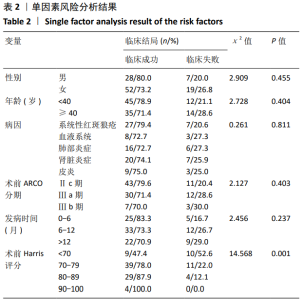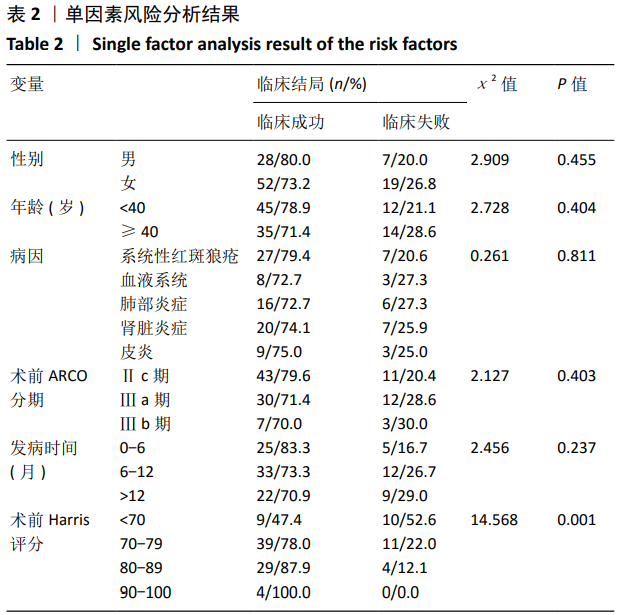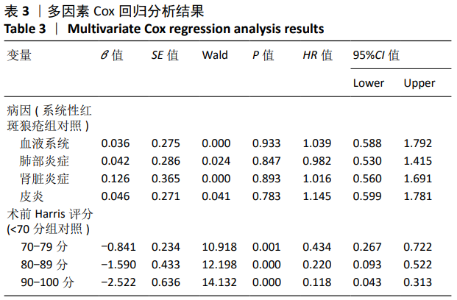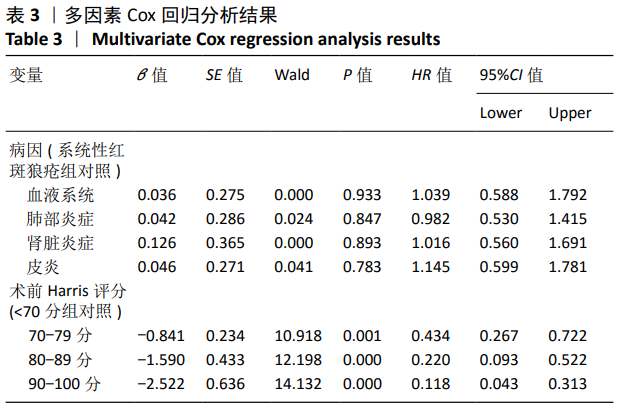Chinese Journal of Tissue Engineering Research ›› 2021, Vol. 25 ›› Issue (6): 906-911.doi: 10.3969/j.issn.2095-4344.2396
Previous Articles Next Articles
Type L1 steroid-induced osteonecrosis of the femoral head through femoral head and neck junction decompression by fenestration: a single-center prospective clinical study
Liu Lihua1, Sun Wei2, Wang Yunting2, Gao Fuqiang2, Cheng Liming2, Li Zirong2, Wang Jiangning1
- 1Department of Orthopedics, Beijing Shijitan Hospital Affiliated to Capital Medical University, Beijing 100038, China; 2Department of Orthopedics, China-Japan Friendship Hospital, Beijing 100029, China
-
Received:2020-04-03Revised:2020-04-10Accepted:2020-05-09Online:2021-02-28Published:2020-12-04 -
Contact:Sun Wei, Chief physician, Professor, Doctoral supervisor, Department of Orthopedics, China-Japan Friendship Hospital, Beijing 100029, China -
About author:Liu Lihua, MD, Attending physician, Department of Orthopedics, Beijing Shijitan Hospital Affiliated to Capital Medical University, Beijing 100038, China -
Supported by:the National Natural Science Foundation of China, No. 81871830, 81672236; the Beijing Municipal Natural Science Foundation, No. 7182146; the Beijing University of Chemical Technology and China-Japan Friendship Hospital Foundation, No. PYBZ1828
CLC Number:
Cite this article
Liu Lihua, Sun Wei, Wang Yunting, Gao Fuqiang, Cheng Liming, Li Zirong, Wang Jiangning. Type L1 steroid-induced osteonecrosis of the femoral head through femoral head and neck junction decompression by fenestration: a single-center prospective clinical study[J]. Chinese Journal of Tissue Engineering Research, 2021, 25(6): 906-911.
share this article
Add to citation manager EndNote|Reference Manager|ProCite|BibTeX|RefWorks

2.3 临床评价 82例患者中术后1例出现股外侧皮神经损伤,2例出现患髋软组织异位骨化表现。 参照末次随访Harris评分,优4髋,良33髋,可50髋,差19髋,优良率为34.9%。末次随访时Harris评分为(83.1±14.3)分,显著高于术前(64.4±9.8)分,差异有显著性意义(P < 0.05)。术前Harris评分<70分组患者中2髋术后3个月疼痛未较术前明显减轻,而行全髋关节置换。 影像观察病灶内成骨明显,植骨区逐步被自体骨替代,平均时间12-18个月。股骨头塌陷进展15髋,单纯影像进展6髋。 2.4 手术疗效相关危险因素分析 单因素分析显示,根据术前Harris评分进行组间比较,<70分组临床失败率52.6%,组间差异有显著性意义(P < 0.05),见表2。"

| [1] MONT MA, PIVEC R, BANERJEE S, et al. High-dose corticosteroid use and risk of hip osteonecrosis: meta-analysis and systematic literature review. J Arthroplasty. 2015;30(9):1506-1512. [2] WANG XS, ZHUANG QY, WENG XS, et al. Etiological and clinical analysis of osteonecrosis of the femoral head in Chinese patients. Chin Med J (Engl). 2013;126(2):290-295. [3] KAMEDA H, AMANO K, NAGASAWA H, et al. Notable difference between the development of vertebral fracture and osteonecrosis of the femoral head in patients treated with high-dose glucocorticoids for systemic rheumatic diseases. Intern Med. 2009;48(22):1931-1938. [4] CE P, GEDIZLIOGLU M, GELAL F, et al. Avascular necrosis of the bones: an overlooked complication of pulse steroid treatment of multiple sclerosis. Eur J Neurol. 2006;13(8):857-861. [5] SAITO M, UESHIMA K, FUJIOKA M, et al. Corticosteroid administration within 2 weeks after renal transplantation affects the incidence of femoral head osteonecrosis. Acta Orthop. 2014;85(3):266-270. [6] EKINCI R, BALCI S, CELIK G, et al. Symptomatic multifocal avascular necrosis in an adolescent with neuropsychiatric systemic lupus erythematosus. Reumatologia. 2019;57(3):182-187. [7] HUSSEIN S, SUITNER M, BELAND-BONENFANT S, et al. Monitoring of Osteonecrosis in Systemic Lupus Erythematosus: A Systematic Review and Metaanalysis. J Rheumatol. 2018;45(10):1462-1476. [8] FUKUSHIMA W, FUJIOKA M, KUBO T, et al. Nationwide epidemiologic survey of idiopathic osteonecrosis of the femoral head. Clin Orthop Relat Res. 2010;468(10):2715-2724. [9] NAKAMURA J, OHTORI S, SAKAMOTO M, et al. Development of new osteonecrosis in systemic lupus erythematosus patients in association with long-term corticosteroid therapy after disease recurrence. Clin Exp Rheumatol. 2010;28(1):13-18. [10] MATTANO LJ, DEVIDAS M, NACHMAN JB, et al. Effect of alternate-week versus continuous dexamethasone scheduling on the risk of osteonecrosis in paediatric patients with acute lymphoblastic leukaemia: results from the CCG-1961 randomised cohort trial. Lancet Oncol. 2012;13(9):906-915. [11] MCAVOY S, BAKER KS, MULROONEY D, et al. Corticosteroid dose as a risk factor for avascular necrosis of the bone after hematopoietic cell transplantation. Biol Blood Marrow Transplant. 2010;16(9):1231-1236. [12] LIM CY, ONG KO. Various musculoskeletal manifestations of chronic renal insufficiency. Clin Radiol. 2013;68(7):e397-e411. [13] SUN W, LI ZR, SHI ZC, et al. Changes in coagulation and fibrinolysis of post-SARS osteonecrosis in a Chinese population. Int Orthop. 2006; 30(3):143-146. [14] MEIER R, KRAUS TM, SCHAEFFELER C, et al. Bone marrow oedema on MR imaging indicates ARCO stage 3 disease in patients with AVN of the femoral head. Eur Radiol. 2014;24(9):2271-2278. [15] CARDENIERS JW. ARCO international stage of osteonecrosis. ARCO Newsletter. 1993;5:79-82. [16] MAUS U, ROTH A, TINGART M, et al. S3 Guideline. Part 3: non-traumatic avascular necrosis in adults-surgical treatment of atraumatic avascular femoral head necrosis in adults. Z Orthop Unfall. 2015;153(5):498-507. [17] 李子荣, 刘朝晖, 孙伟, 等. 基于三柱结构的股骨头坏死分型——中日友好医院分型[J]. 中华骨科杂志,2012,32(6):515-520. [18] 孙伟, 李子荣, 高福强, 等. 磷酸三钙多孔生物陶瓷修复股骨头坏死[J]. 中国组织工程研究,2014,18(16):2474-2479. [19] SUN W, LI ZR, WANG BL, et al. Relationship between preservation of the lateral pillar and collapse of the femoral head in patients with osteonecrosis. Orthopedics. 2014;37(1): e24-e28. [20] ROSENWASSER MP, GARINO JP, KIERNAN HA, et al. Long term followup of thorough debridement and cancellous bone grafting of the femoral head for avascular necrosis. Clin Orthop Relat Res. 1994;(306):17-27. [21] MONT MA, ETIENNE G, RAGLAND PS. Outcome of nonvascularized bone grafting for osteonecrosis of the femoral head. Clin Orthop Relat Res. 2003;(417):84-92. [22] 李子荣. 股骨头坏死临床诊疗规范[J]. 中华骨与关节外科杂志, 2015,8(1):1-6. [23] ERIVAN R, CAPUTO T, RIOUACH H, et al. Primary total hip replacement in Ficat-Arlet stage 3 and 4 osteonecrosis: a retrospective study at a minimum 12-year follow-up. Eur J Orthop Surg Traumatol. 2020;30(5): 845-850. [24] PARK CW, LIM SJ, KIM JH, et al. Hip resurfacing arthroplasty for osteonecrosis of the femoral head: Implant-specific outcomes and risk factors for failure. J Orthop Translat. 2020;21:41-48. [25] KOBAYASHI S, KUBO T, IWAMOTO Y, et al. Nationwide multicenter follow-up cohort study of hip arthroplasties performed for osteonecrosis of the femoral head. Int Orthop. 2018;42(7):1661-1668. [26] PIERCE TP, ELMALLAH RK, JAUREGUI JJ, et al. Outcomes of total hip arthroplasty in patients with osteonecrosis of the femoral head-a current review. Curr Rev Musculoskelet Med. 2015;8(3):246-251. [27] 李子荣. 股骨头坏死:早期诊断与个体化治疗[J]. 中国矫形外科杂志, 2013,21(19):1909-1911. [28] ANIS HK, SODHI N, EHIOROBO JO, et al. Joint preservation procedures for osteonecrosis. Instr Course Lect. 2020,69:129-138. [29] 左伟,孙伟,高福强,等. 经头颈部开窗打压植骨治疗股骨头已部分塌陷股骨头坏死疗效分析[J]. 中国修复重建外科杂志, 2016, 30(4):397-401. [30] SEYLER TM, MARKER DR, ULRICH SD, et al. Nonvascularized bone grafting defers joint arthroplasty in hip osteonecrosis. Clin Orthop Relat Res. 2008;466(5):1125-1132. [31] SUN W, LI Z, GAO F, et al. Recombinant human bone morphogenetic protein-2 in debridement and impacted bone graft for the treatment of femoral head osteonecrosis. PLoS One. 2014;9(6):e100424. [32] EWARD WC, RINEER CA, URBANIAK JR, et al. The vascularized fibular graft in precollapse osteonecrosis: is long-term hip preservation possible? Clin Orthop Relat Res. 2012;470(10):2819-2826. [33] PHEMISTER DB. Treatment of the necrotic head of the femur in adults. J Bone Joint Surg Am. 1949;31A(1):55-66. [34] 陈雷雷, 洪志楠, 洪郭驹, 等. 打压支撑植骨术治疗股骨头坏死的中长期疗效与影响因素分析[J]. 中华骨科杂志, 2018,38(7):403-410. [35] MEYERS MH, JONES RE, BUCHOLZ RW, et al. Fresh autogenous grafts and osteochondral allografts for the treatment of segmental collapse in osteonecrosis of the hip. Clin Orthop Relat Res. 1983;(174):107-112. [36] SULTAN AA, KHLOPAS A, SURACE P, et al. The use of non-vascularized bone grafts to treat osteonecrosis of the femoral head: indications, techniques, and outcomes. Int Orthop. 2019;43(6):1315-1320. [37] PIERCE TP, ELMALLAH RK, JAUREGUI JJ, et al. A current review of non-vascularized bone grafting in osteonecrosis of the femoral head. Curr Rev Musculoskelet Med. 2015;8(3):240-245. [38] MONT MA, ZYWIEL MG, MARKER DR, et al. The natural history of untreated asymptomatic osteonecrosis of the femoral head: a systematic literature review. J Bone Joint Surg Am. 2010;92(12): 2165-2170. [39] SHIGEMURA T, NAKAMURA J, KISHIDA S, et al. Incidence of osteonecrosis associated with corticosteroid therapy among different underlying diseases: prospective MRI study. Rheumatology(Oxford). 2011;50(11):2023-2028. [40] SEKIYA F, YAMAJI K, YANG K, et al. Investigation of occurrence of osteonecrosis of the femoral head after increasing corticosteroids in patients with recurring systemic lupus erythematosus. Rheumatol Int. 2010;30(12):1587-1593. [41] MELONI MC, HOEDEMAEKER WR, FORNASIER V. Failed vascularized fibular graft in treatment of osteonecrosis of the femoral head. A histopathological analysis. Joints. 2016;4(1):24-30. [42] HAUZEUR JP, MALAISE M, DE MAERTELAER V. A prospective cohort study of the clinical presentation of non-traumatic osteonecrosis of the femoral head: spine and knee symptoms as clinical presentation of hip osteonecrosis. Int Orthop. 2016;40(7):1347-1351. [43] MONT MA, CARBONE JJ, FAIRBANK AC. Core decompression versus nonoperative management for osteonecrosis of the hip. Clin Orthop Relat Res. 1996;(324):169-178. |
| [1] | Xu Feng, Kang Hui, Wei Tanjun, Xi Jintao. Biomechanical analysis of different fixation methods of pedicle screws for thoracolumbar fracture [J]. Chinese Journal of Tissue Engineering Research, 2021, 25(9): 1313-1317. |
| [2] | Jiang Yong, Luo Yi, Ding Yongli, Zhou Yong, Min Li, Tang Fan, Zhang Wenli, Duan Hong, Tu Chongqi. Von Mises stress on the influence of pelvic stability by precise sacral resection and clinical validation [J]. Chinese Journal of Tissue Engineering Research, 2021, 25(9): 1318-1323. |
| [3] | Zhang Tongtong, Wang Zhonghua, Wen Jie, Song Yuxin, Liu Lin. Application of three-dimensional printing model in surgical resection and reconstruction of cervical tumor [J]. Chinese Journal of Tissue Engineering Research, 2021, 25(9): 1335-1339. |
| [4] | Zhang Yu, Tian Shaoqi, Zeng Guobo, Hu Chuan. Risk factors for myocardial infarction following primary total joint arthroplasty [J]. Chinese Journal of Tissue Engineering Research, 2021, 25(9): 1340-1345. |
| [5] | Wei Wei, Li Jian, Huang Linhai, Lan Mindong, Lu Xianwei, Huang Shaodong. Factors affecting fall fear in the first movement of elderly patients after total knee or hip arthroplasty [J]. Chinese Journal of Tissue Engineering Research, 2021, 25(9): 1351-1355. |
| [6] | Wang Jinjun, Deng Zengfa, Liu Kang, He Zhiyong, Yu Xinping, Liang Jianji, Li Chen, Guo Zhouyang. Hemostatic effect and safety of intravenous drip of tranexamic acid combined with topical application of cocktail containing tranexamic acid in total knee arthroplasty [J]. Chinese Journal of Tissue Engineering Research, 2021, 25(9): 1356-1361. |
| [7] | Xiao Guoqing, Liu Xuanze, Yan Yuhao, Zhong Xihong. Influencing factors of knee flexion limitation after total knee arthroplasty with posterior stabilized prostheses [J]. Chinese Journal of Tissue Engineering Research, 2021, 25(9): 1362-1367. |
| [8] | Huang Zexiao, Yang Mei, Lin Shiwei, He Heyu. Correlation between the level of serum n-3 polyunsaturated fatty acids and quadriceps weakness in the early stage after total knee arthroplasty [J]. Chinese Journal of Tissue Engineering Research, 2021, 25(9): 1375-1380. |
| [9] | Zhang Chong, Liu Zhiang, Yao Shuaihui, Gao Junsheng, Jiang Yan, Zhang Lu. Safety and effectiveness of topical application of tranexamic acid to reduce drainage of elderly femoral neck fractures after total hip arthroplasty [J]. Chinese Journal of Tissue Engineering Research, 2021, 25(9): 1381-1386. |
| [10] | Wang Haiying, Lü Bing, Li Hui, Wang Shunyi. Posterior lumbar interbody fusion for degenerative lumbar spondylolisthesis: prediction of functional prognosis of patients based on spinopelvic parameters [J]. Chinese Journal of Tissue Engineering Research, 2021, 25(9): 1393-1397. |
| [11] | Lü Zhen, Bai Jinzhu. A prospective study on the application of staged lumbar motion chain rehabilitation based on McKenzie’s technique after lumbar percutaneous transforaminal endoscopic discectomy [J]. Chinese Journal of Tissue Engineering Research, 2021, 25(9): 1398-1403. |
| [12] | Chen Xinmin, Li Wenbiao, Xiong Kaikai, Xiong Xiaoyan, Zheng Liqin, Li Musheng, Zheng Yongze, Lin Ziling. Type A3.3 femoral intertrochanteric fracture with augmented proximal femoral nail anti-rotation in the elderly: finite element analysis of the optimal amount of bone cement [J]. Chinese Journal of Tissue Engineering Research, 2021, 25(9): 1404-1409. |
| [13] | Du Xiupeng, Yang Zhaohui. Effect of degree of initial deformity of impacted femoral neck fractures under 65 years of age on femoral neck shortening [J]. Chinese Journal of Tissue Engineering Research, 2021, 25(9): 1410-1416. |
| [14] | Zhang Shangpu, Ju Xiaodong, Song Hengyi, Dong Zhi, Wang Chen, Sun Guodong. Arthroscopic suture bridge technique with suture anchor in the treatment of acromioclavicular dislocation [J]. Chinese Journal of Tissue Engineering Research, 2021, 25(9): 1417-1422. |
| [15] | Liang Yan, Zhao Yongfei, Xu Shuai, Zhu Zhenqi, Wang Kaifeng, Liu Haiying, Mao Keya. Imaging evaluation of short-segment fixation and fusion for degenerative lumbar scoliosis assisted by highly selective nerve root block [J]. Chinese Journal of Tissue Engineering Research, 2021, 25(9): 1423-1427. |
| Viewed | ||||||
|
Full text |
|
|||||
|
Abstract |
|
|||||



